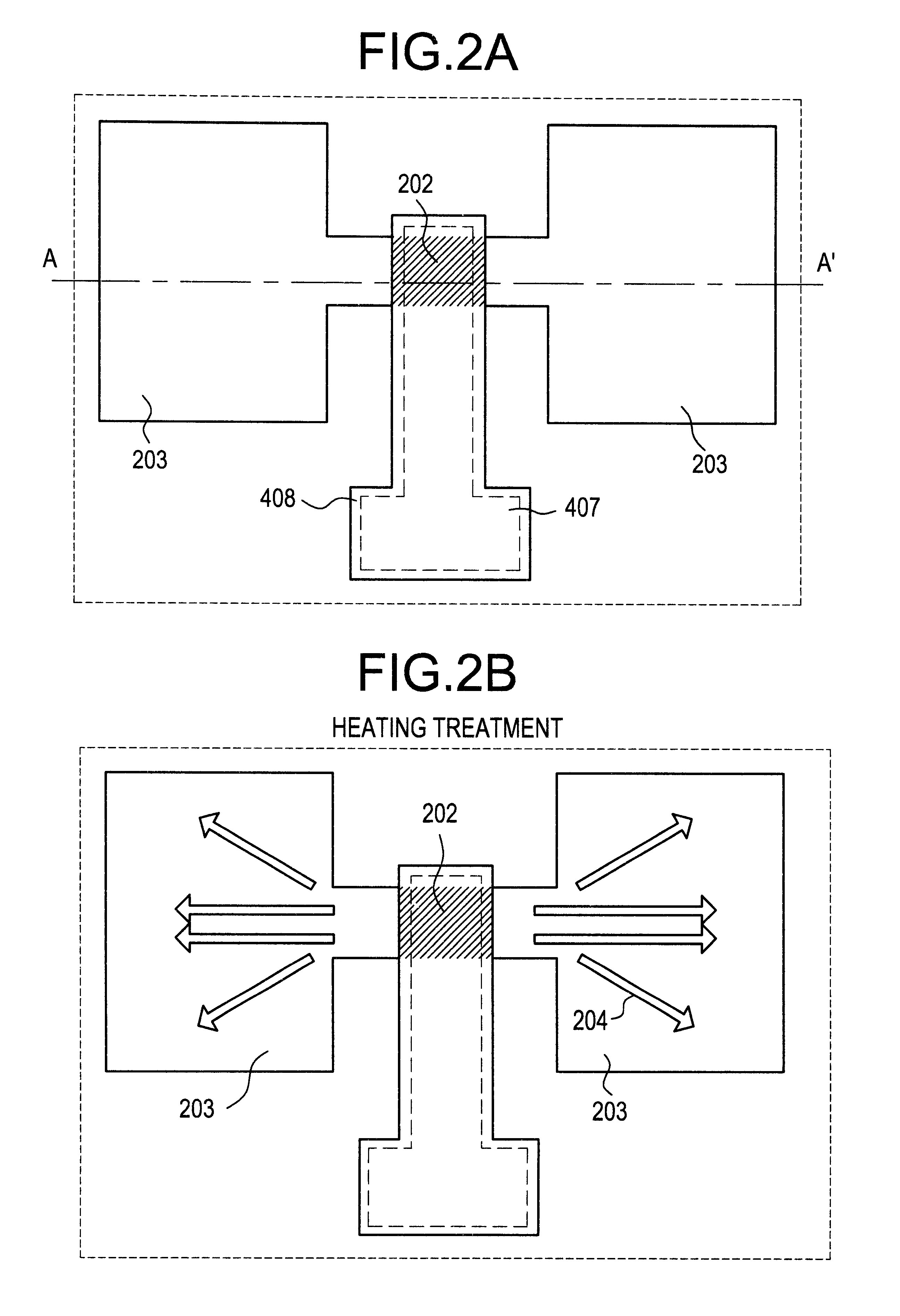Semiconductor device and method for producing the same
a technology of thin film transistor and semiconductor device, which is applied in the direction of semiconductor device, electrical apparatus, transistor, etc., can solve the problems of inferior tft based on amorphous silicon film, inability to manufacture cmos circuits, and limited substrate type of materials
- Summary
- Abstract
- Description
- Claims
- Application Information
AI Technical Summary
Benefits of technology
Problems solved by technology
Method used
Image
Examples
example 2
The present example is similar to Example 1, except for forming the gate electrode 407 with silicon or a silicide (a compound of a metal with silicon). In FIG. 5A, the heating treatment can be performed at the crystallization temperature of amorphous silicon or higher, i.e., 450.degree. C. or higher. However, the heating treatment must be effected at a temperature not higher than the deformation temperature of the glass substrate, for instance, at 550.degree. C. By the heating treatment, as shown in FIG. 2B, the region 203 once rendered amorphous is crystallized, and nickel element diffuses out from the crystalline region 202 along the progressive direction of crystal growth. Finally, nickel element is found to concentrate in the end portion of the region 203.
The later steps can be effected in a similar manner as those described in Example 1, to complete a TFT.
example 3
The present example is an example of a method for performing heating treatment to allow the crystals grow from the region into which the metal element for accelerating the crystallization of silicon is introduced, and then producing a TFT using the obtained region. The producing method of the example differs from that described in Example 1 in two aspects; one is concerned with the relation between the region into which the metal element is introduced and the region to be crystallized, and the other is concerned with the morphology of the crystallized portion.
In the example, the region into which the metal element is introduced is crystallized, and then the active layer (channel forming region) of the TFT is produced by using the crystallized region.
FIGS. 6A and 6B shows a part of the method for producing a TFT. In FIG. 6A, nickel element is introduced into a hatched region 601. Nickel element can be introduced in a manner similar to that employed in Example 1. However, it is necess...
example 4
In the present example, nickel element is introduced not selectively, but over the entire surface of the amorphous silicon film. Thus, in the processes shown in FIG. 1A and in FIG. 4A, a nickel acetate solution may be applied to the whole surface of the amorphous silicon film 403 without forming any masks (as shown by 404 in FIG. 4A)
When the example is employed, nickel is provided at the same concentration in the entire pattern region 105 in FIG. 1B or FIG. 4C. Accordingly, a diffusion of nickel which occurs from the region containing nickel at a high concentration to that containing no nickel (more precisely, a region containing nickel at a concentration below the detection limit or at an extremely low concentration) cannot be expected in this case.
However, after implanting impurity ions for the formation of source / drain regions as shown in FIG. 2A, since the regions other than the region 202 which becomes the channel forming region are rendered amorphous, if heating treatment perf...
PUM
| Property | Measurement | Unit |
|---|---|---|
| temperature | aaaaa | aaaaa |
| temperature | aaaaa | aaaaa |
| heat resistance | aaaaa | aaaaa |
Abstract
Description
Claims
Application Information
 Login to View More
Login to View More - R&D
- Intellectual Property
- Life Sciences
- Materials
- Tech Scout
- Unparalleled Data Quality
- Higher Quality Content
- 60% Fewer Hallucinations
Browse by: Latest US Patents, China's latest patents, Technical Efficacy Thesaurus, Application Domain, Technology Topic, Popular Technical Reports.
© 2025 PatSnap. All rights reserved.Legal|Privacy policy|Modern Slavery Act Transparency Statement|Sitemap|About US| Contact US: help@patsnap.com



